Western Europe facts for kids
Western Europe is a part of Europe that is farthest from Asia. The countries included in Western Europe can change depending on who is talking about it.
Long ago, around the 1400s, people started exploring the world. At this time, the idea of "Europe" as "the West" slowly began to replace the older idea of "Christendom" (meaning Christian lands) as the way people in the region saw themselves. Later, during a time called the Age of Enlightenment, the idea of "Eastern Europe" was created to help define "Western Europe" even more clearly.
Contents
Historical divisions of Western Europe
Ancient times and the Middle Ages
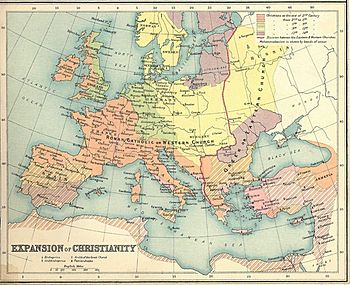
Before the Romans took over, many parts of Western Europe used a new style called the La Tène culture. As the Roman Empire grew, a difference appeared between the eastern areas, which mostly spoke Greek and had many cities, and the western areas, which mostly spoke Latin. This language and culture split became even stronger when the Roman Empire itself divided into two parts: the Western Roman Empire and the Eastern Roman Empire. These two empires controlled their different regions from the 3rd to the 5th centuries.
This split became even bigger during the Middle Ages. The Western Roman Empire collapsed, which started the Early Middle Ages. But the Eastern Roman Empire, also known as the Byzantine Empire, kept going strong for another 1000 years. In the west, the Carolingian Empire grew. A major event that made the cultural and religious differences even clearer was the Great Schism. This was when the Christian church officially split into the Eastern Orthodox Church and the Catholic Church.
After the Byzantine Empire (which was the center of the Eastern Orthodox Church) was taken over by the Ottoman Empire in the 15th century, and the Holy Roman Empire slowly broke apart, the difference between Catholic and Protestant Christians became more important in Europe than the difference with Eastern Orthodoxy.
In East Asia, Western Europe was known as taixi in China and taisei in Japan. Both names mean "Far West." This term became common in China during the Ming dynasty. A Jesuit priest named Matteo Ricci was one of the first people in China to use "Far West" to describe Western Europe, just like Europeans used "Far East" for Asia. Ricci even called himself "Matteo of the Far West." This term was still used in the late 1800s and early 1900s.
Religion in Western Europe
Christianity is the biggest religion in Western Europe. A study from 2018 showed that about 71% of people in Western Europe said they were Christians.
In 1054, the East–West Schism divided Christianity into Western Christianity and Eastern Christianity. This split Europe in two. Western Europe mostly followed the Catholic Church, while Eastern Europe followed the Eastern Orthodox Church. After the Reformation in the 1500s, the main Christian groups in Western Europe became Catholicism and Protestantism.
Because of this religious split, Western Europe often includes countries in Northern and Central Europe, while Eastern Europe includes countries in Southeastern Europe.
The Cold War era
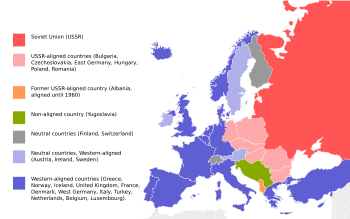
During the Cold War, which lasted about 40 years, the idea of East and West became very simple. There was the Eastern Bloc, led by the Soviet Union, and the Western Bloc, led by the United States. Today, historians and scientists usually see this Cold War definition as old-fashioned.
At the end of World War II in 1945, leaders like Winston Churchill (from Britain), Franklin D. Roosevelt (from the U.S.), and Joseph Stalin (from the Soviet Union) met at the Yalta Conference. They decided how Europe would be set up after the war.
Europe was divided into two main areas: the Western Bloc, which was influenced by the United States, and the Eastern Bloc, which was influenced by the Soviet Union. As the Cold War began, a clear line called the "Iron Curtain" divided Europe. Winston Churchill made this term very famous in a speech in 1946. He said:
From Stettin in the Baltic to Trieste in the Adriatic an iron curtain has descended across the Continent. Behind that line lie all the capitals of the ancient states of Central and Eastern Europe. Warsaw, Berlin, Prague, Vienna, Budapest, Belgrade, Bucharest and Sofia; all these famous cities and the populations around them lie in what I must call the Soviet sphere, and all are subject, in one form or another, not only to Soviet influence but to a very high and in some cases increasing measure of control from Moscow.
Even though some countries were officially neutral, they were still grouped based on their political and economic systems. This division from the Cold War still shapes how many people think about Western Europe and its borders with Eastern Europe.
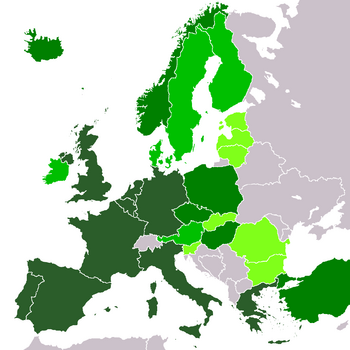
The world changed a lot when the Iron Curtain fell in 1989. West Germany and East Germany reunited peacefully. Groups like Comecon and the Warsaw Pact ended, and in 1991, the Soviet Union itself broke apart. Many countries that were part of the Soviet Union became fully independent again.
Western European Union
In 1948, the Treaty of Brussels was signed by Belgium, France, Luxembourg, the Netherlands, and the United Kingdom. In 1954, the Western European Union was created. This union was officially ended in 2011. When it dissolved, it had 10 member countries and many other partner countries.
Modern ways to define Western Europe
United Nations classification
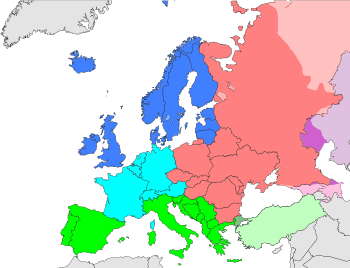
Eastern Europe Northern Europe Southern Europe Western Europe
The United Nations Statistics Division (UNSD) has a system to divide the world's countries into regions. This is mainly for collecting statistics and does not mean anything about politics.
In the UN system, these countries are part of Western Europe:
Geography: Realms, Regions, and Concepts
The textbook Geography: Realms, Regions, and Concepts is used in many schools in the U.S. to teach about world geography. It has been published since 1971.
In this book, Western Europe includes:
- Austria
- Belgium
- Czech Republic
- France
- Germany
- Ireland
- Liechtenstein
- Luxembourg
- Monaco
- Netherlands
- Switzerland
- United Kingdom
CIA classification
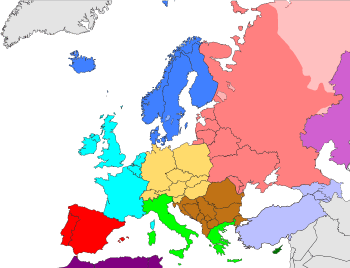
The CIA lists seven countries as belonging to "Western Europe":
The CIA also lists three countries as part of "Southwestern Europe":
EuroVoc classification
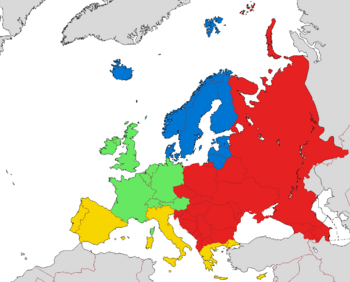
EuroVoc is a collection of terms used by the Publications Office of the European Union. In this system, European countries are grouped into sub-regions. The following countries are in the "Western Europe" group:
- Andorra
- Austria
- Belgium
- France
- Germany
- Ireland
- Liechtenstein
- Luxembourg
- Monaco
- Netherlands
- Switzerland
- United Kingdom
Western European and Others Group
The Western European and Others Group is one of the unofficial groups at the United Nations. These groups help countries vote and discuss things together. They were formed in 1961 to make sure different regions were represented in UN bodies. The European members of this group are:
Also, Australia, Canada, Israel, and New Zealand are members of this group. The United States is an observer.
Population of Western Europe
Here's a look at the population of Western Europe, using the CIA's definition. These numbers are from 2018.
| Rank | Country or territory | Population (most recent estimates) | Languages | Capital |
|---|---|---|---|---|
| 1 | United Kingdom | 66,040,229 | English | London |
| 2 | France (metropolitan) | 65,058,000 | French | Paris |
| 3 | Netherlands | 17,249,632 | Dutch, Frisian | Amsterdam |
| 4 | Belgium | 11,420,163 | Dutch, French and German | Brussels |
| 5 | Ireland | 4,857,000 | Irish, English | Dublin |
| 6 | Luxembourg | 602,005 | French, Luxembourgish and German | Luxembourg City |
| 7 | Monaco | 38,300 | French | Monaco (city-state) |
| Total | 165,265,329 |
If we include the "South-Western Europe" countries from the CIA classification, the population numbers change:
| Rank | Country or territory | Population (most recent estimates) | Languages | Capital |
|---|---|---|---|---|
| 1 | United Kingdom | 66,040,229 | English | London |
| 2 | France (metropolitan) | 65,058,000 | French | Paris |
| 3 | Spain | 46,700,000 | Spanish, Galician, Catalan, Basque | Madrid |
| 4 | Netherlands | 17,249,632 | Dutch, Frisian | Amsterdam *Note: The Hague is the seat of government |
| 5 | Belgium | 11,420,163 | Dutch, French | Brussels |
| 6 | Portugal | 10,291,027 | Portuguese | Lisbon |
| 7 | Ireland | 4,857,000 | Irish, English | Dublin |
| 8 | Luxembourg | 602,005 | French, Luxembourgish and German | Luxembourg City |
| 9 | Andorra | 78,264 | Catalan | Andorra la Vella |
| 10 | Monaco | 38,300 | French | Monaco (city-state) |
| Total | 222,293,922 |
Climate in Western Europe

The weather in Western Europe changes a lot from place to place. Along the coasts of Italy, Portugal, and Spain, it can be subtropical (warm all year) or semi-arid (dry). In the Pyrenees and the Alps mountains, the climate is alpine, meaning it's cold and snowy. The southern parts have a Mediterranean climate, which is usually dry and warm. The western and northwestern areas have a mild, often wet climate because of the North Atlantic Current in the ocean.
Languages of Western Europe
Most languages in Western Europe belong to two main language families:
- The Romance languages, which came from the Latin spoken in the Roman Empire.
- The Germanic languages, which came from an older language called Proto-Germanic from southern Scandinavia.
Romance languages are mostly spoken in the southern and central parts of Western Europe. Germanic languages are spoken in the northern parts, like the British Isles and the Low Countries, as well as much of Northern and Central Europe.
Other languages in Western Europe include the Celtic group. These are Irish, Scottish Gaelic, Manx, Welsh, Cornish, and Breton. There's also Basque, which is a unique language that isn't related to any other living European language.
Today, many countries in Western Europe want to protect and support different languages, especially regional and minority languages. The Council of Europe has agreements like the Framework Convention for the Protection of National Minorities and the European Charter for Regional or Minority Languages. These agreements help set up rules for language rights in Europe.
Economy of Western Europe
Western Europe is one of the richest parts of the world. Germany has the highest gross domestic product (GDP) in Europe, which means it produces the most goods and services. Germany also has the largest financial surplus of any country. Luxembourg has the highest GDP per person in the world. Germany also has the highest total wealth of any European country.
Switzerland and Luxembourg have some of the highest average wages in the world. Norway ranks very high on the Social Progress Index, which measures how well a country meets the social and environmental needs of its citizens.
See also
In Spanish: Europa Occidental para niños


